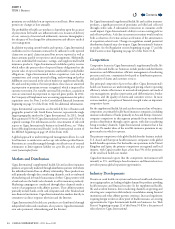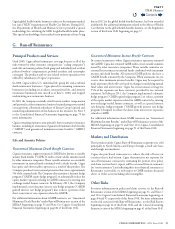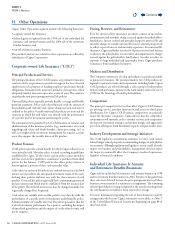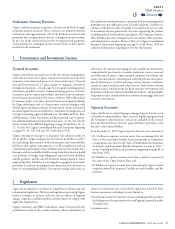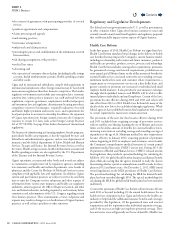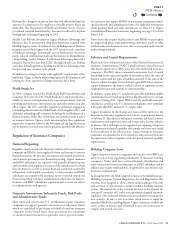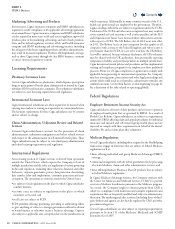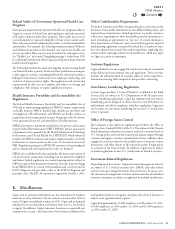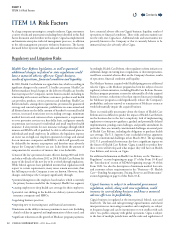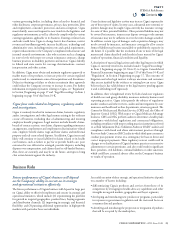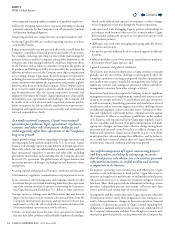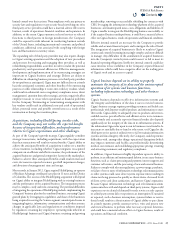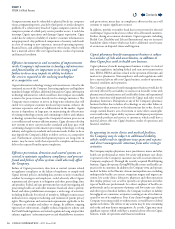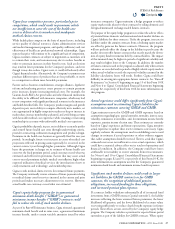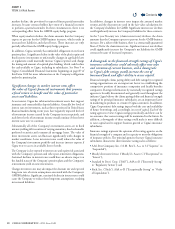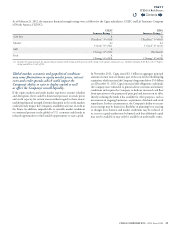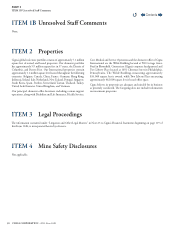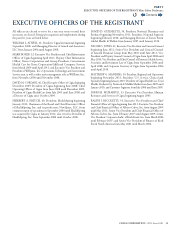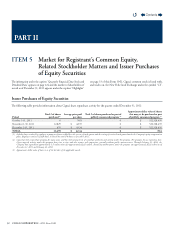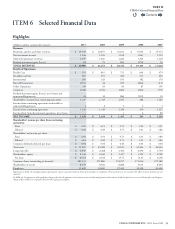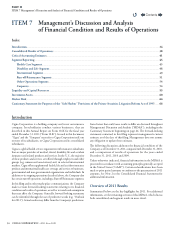Cigna 2011 Annual Report Download - page 46
Download and view the complete annual report
Please find page 46 of the 2011 Cigna annual report below. You can navigate through the pages in the report by either clicking on the pages listed below, or by using the keyword search tool below to find specific information within the annual report.
24 CIGNA CORPORATION2011 Form10K
PARTI
ITEM 1A Risk Factors
•attracting and retaining sucient numbers of qualied employees;
•
eectively managing balance sheet exposures, including evaluating
potential solutions for the Company’s run-o reinsurance business
and pension funding obligation;
•improving medical cost competitiveness in targeted markets; and
•
reducing Cigna HealthCare’s medical operating expenses to achieve
sustainable benets.
If these initiatives fail or are not executed eectively, it could harm the
Company’s consolidated nancial position and results of operations.
For example, reducing operating expenses while maintaining the
necessary resources and the Company’s talent pool is important to the
Company and, if not managed eectively, could have long-term eects
on the business such as failure to maintain or improve the quality of
its products and limiting its ability to retain or hire key personnel. In
addition, in order to succeed, the Company must align its organization
to its evolving strategy. Cigna must eectively integrate its operations,
including the most recent HealthSpring acquisition, actively work to
ensure consistency throughout the organization, and promote a global
mind-set and a focus on individual customers. If the Company fails to
do so, it may be unable to grow as planned, and the result of expansion
may be unsatisfactory. Also, the current competitive, economic and
regulatory environment will require Cigna’s organization to adapt rapidly
and nimbly to new opportunities and challenges. e Company will
be unable to do so if it does not make important decisions quickly,
dene its appetite for risk specically, implement new governance,
managerial and organizational processes smoothly and communicate
roles and responsibilities clearly.
As a multi-national company, Cigna’s international
operations face political, legal, operational, regulatory,
economic and other risks that present challenges and
could negatively affect those operations or the Company’s
long-term growth.
Cigna’s growth strategy involves expanding its foreign operations and
entering targeted new markets outside of the U.S. As a result, Cigna’s
business is increasingly exposed to risks inherent in foreign operations.
ese risks, which can vary substantially by market, include political,
legal, operational, regulatory, economic and other risks, including
government intervention and censorship that the Company does not
face in its U.S. operations. e global nature of Cigna’s business and
operations presents challenges, including but not limited to those
arising from:
•
varying regional and geopolitical business conditions and demands;
•
discriminatory regulation, nationalization or expropriation of assets;
•
price controls or other pricing issues and exchange controls or other
restrictions that prevent it from transferring funds from these operations
out of the countries in which it operates or converting local currencies
that Cigna International holds into U.S.dollars or other currencies;
•
foreign currency exchange rates and uctuations that may have an
impact on the future costs or on future sales and cash ows from the
Company’s international operations, and any measures that it may
implement to reduce the eect of volatile currencies and other risks
of its international operations may not be eective;
•
reliance on local sales forces for some of its operations in countries
that may have labor problems and less exible employee relationships,
which can be dicult and expensive to terminate, or where changes
in local regulation or law may disrupt the business operations;
•
risk associated with managing Cigna’s partner relationships in
accordance with business objectives in countries where Cigna
International voluntarily operates or is required to operate with
local business partners;
•
challenges associated with managing more geographically diverse
operations and projects;
•
the need to provide sucient levels of technical support in dierent
locations;
•
political instability or acts of war, terrorism, natural disasters, pandemics
in locations where Cigna operates; and
•general economic and political conditions.
ese factors may increase in importance as Cigna continues to expand
globally, and any one of these challenges could negatively aect the
Company’s operations or its long-term growth. Further, expansion into
new markets may require considerable management time before any
signicant revenues and earnings are generated, which could divert
management’s attention from other strategic activities.
International operations also require the Company to devote signicant
management resources to implement its controls and systems in new
markets, to comply with the U.S. anti-bribery and anti-corruption
as well as anti-money laundering provisions and similar laws in local
jurisdictions and to overcome logistical and other challenges based
on diering languages, cultures and time zones. Violations of these
laws and regulations could result in nes, criminal sanctions against
the Company, its ocers or employees, prohibitions on the conduct
of its business, and reputational harm. Cigna must regularly reassess
the size, capability and location of its global infrastructure and make
appropriate changes, and must have eective change management
processes and internal controls in place to address changes in its
business and operations. Cigna’s success depends, in part, on its ability
to anticipate these risks and manage these diculties, and the failure to
do so could have a material adverse eect on Cigna’s business, results
of operations, nancial condition and long-term growth.
Successful management of Cigna’s outsourcing projects
and key vendors, including by taking steps to ensure
that third parties who obtain access to sensitive personal
information maintain its confidentiality and security,
is important to its business.
To improve operating costs, productivity and eciencies, Cigna
outsources selected functions to third parties. Cigna takes steps to
monitor and regulate the performance of independent third parties
who provide services or to whom the Company delegates selected
functions. ese third parties include information technology system
providers, independent practice associations, call center and claim
service providers and various types of service providers.
Arrangements with key vendors may make Cigna’s operations vulnerable
if third parties fail to satisfy their obligations to the Company as a
result of their performance, changes in their own operations, nancial
condition, or other matters outside of Cigna’s control, including their
obligations to maintain and protect the security and condentiality of
the Company’s information and data. Even though its contracts with
third-party providers provide certain protection, the Company has
Contents
Q


